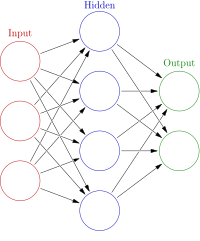
Photo from wikipedia
Physics‐informed neural networks have gained growing interest. Specifically, they are used to solve partial differential equations governing several physical phenomena. However, physics‐informed neural network models suffer from several issues and… Click to show full abstract
Physics‐informed neural networks have gained growing interest. Specifically, they are used to solve partial differential equations governing several physical phenomena. However, physics‐informed neural network models suffer from several issues and can fail to provide accurate solutions in many scenarios. We discuss a few of these challenges and the techniques, such as the use of Fourier transform, that can be used to resolve these issues. This paper proposes and develops a physics‐informed neural network model that combines the residuals of the strong form and the potential energy, yielding many loss terms contributing to the definition of the loss function to be minimized. Hence, we propose using the coefficient of variation weighting scheme to dynamically and adaptively assign the weight for each loss term in the loss function. The developed PINN model is standalone and meshfree. In other words, it can accurately capture the mechanical response without requiring any labeled data. Although the framework can be used for many solid mechanics problems, we focus on three‐dimensional (3D) hyperelasticity, where we consider two hyperelastic models. Once the model is trained, the response can be obtained almost instantly at any point in the physical domain, given its spatial coordinates. We demonstrate the framework's performance by solving different problems with various boundary conditions.
Journal Title: International Journal for Numerical Methods in Engineering
Year Published: 2022
Link to full text (if available)
Share on Social Media: Sign Up to like & get
recommendations!